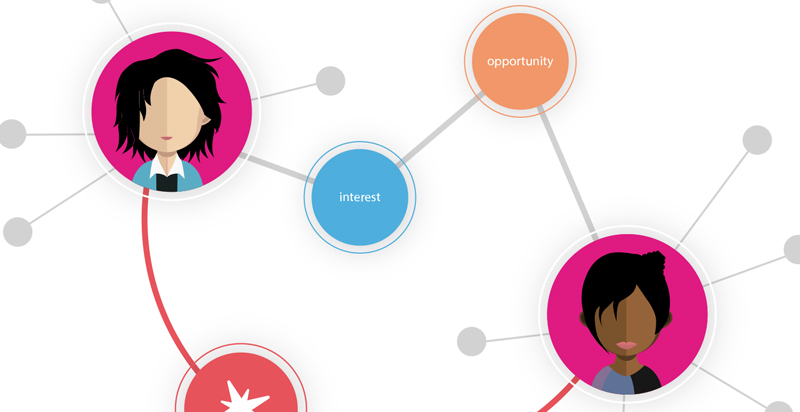The Einstellung effect is a psychological phenomenon that changes the way we all come to solutions and impedes innovation.
Read More »Blog
The Sticky Note Exercise: FREE RESOURCE
How do you pick who works together, who reports to whom, and who exchanges information with whom? Usually it gets done within a department, within a project team, or based on some other common ground. It turns out we should be focusing on our differences a bit more.
Read More »Human Resource Management: Utilizing your collective intelligence for team optimization
Human Resources... HR... Human Capital Management, no matter what you call it, people are the beating heart of any organization. Taking a data driven approach to mapping the skill-sets of the people in your organization not only allows Leadership to optimize team formation, but provides an opportunity for hidden talents in your people to emerge.
Read More »Innovating With The Team You've Got
You can find all sorts of “how to” treatises on assembling a team built for innovation, and they all include some subset of the following concepts - bring in experts, make sure they are diverse, have wide-ranging skillsets and have them be people who aren’t afraid to buck the system or go against the flow. Then don’t distract them with mundane tasks and give them enough time and money to actually accomplish their innovation mandate.
Read More »No, you can’t “Gift” tear gas in the office gift exchange
Unlocking team creativity during a pandemic.
Read More »The Best Innovation Management Software Translates Between Teams
We’re all familiar with the way knowledge is siloed by organizational structures and the momentum of daily work. Cross-pollination is key to innovation, but it goes against the current. So it’s hard, and the serendipity of chance conversations at the water cooler or a conference happy-hour often determines if it happens.
Read More »The Best Innovation Management Software Captures the Context of Ideas
Most innovation management software (a.k.a. innovation software) is focused on generating and curating ideas. Ideas are explicit. They’ve been articulated, inside your head at the very least. Implicit knowledge, the context of an idea, is where many big opportunities reside.
Read More »Innovation Management Software for Interdisciplinary Communities
It’s hard to create effective interdisciplinary teams or facilitate useful interdisciplinary exchanges. Research grants are increasingly calling for interdisciplinary collaboration as a requirement for funding. Interdisciplinary endeavors are popping up in academic settings and research foundations. Interdisciplinarity is a necessity for solving complex problems. But executing interdisciplinary collaboration is easier said than done.
Read More »'Translators' as Contributors in Collaborative Teams
For 20 years, I have worked with researchers in academic settings to help them design, develop and obtain resources to support the research they do. Over those 20 years, I have cultivated relationships and developed partnerships to the benefit of these researchers, sometimes brokering relationships and other times developing partnerships on behalf of others. I am not advancing my own research or research interests. Instead, I am developing my own understanding of what others do with their research and communicating that understanding to other audiences. Knowledge transfer of this sort is somewhat common in academia, and in other sectors such as industry or non-profit organizations, this form of communication might also be referred to as marketing, storytelling, and/or knowledge mobilization.
Read More »The Best Innovation Management Software for Complex Problems
Some problems are complicated. Finding a solution requires expertise and analysis, but the solution exists. Sky scrapers are complicated. Some problems are complex or even wicked. These problems have no solution. They’re too big, too slippery, too thorny.
Read More »Recent Posts
Posts by Author
- AIBS BioScience Talks (1)
- Alanna Riederer (1)
- Austin Schwinn (2)
- Clive Higgins (3)
- Dave King (7)
- Derek Grape (2)
- Dr. Alicia Knoedler (2)
- Frank D. Evans (4)
- Jeff Johnston (1)
- Jill Macchiaverna (9)
- Josh Southerland (1)
- Ken Goulding (1)
- Luke Tucker (3)
- Matt Coatney (3)
- Matthew Schroyer (4)
- Mike Perez (10)
- Sandeep Sikka (1)
- Shannan Callies (2)
- Stephen Arra (1)
- Terri Gilbert (2)
- Tom Lambert (2)
Posts by Tag
- Innovation (19)
- collaboration (19)
- team building (17)
- Data Applications (15)
- Data Science (14)
- collaborate (13)
- new idea (13)
- Data Visualization (12)
- cognitive city (11)
- cognitive network (11)
- teambuilding (11)
- discovery (10)
- thought leadership (10)
- Exaptation (9)
- research (9)
- technology (8)
- Data Exploration (7)
- Platforms (7)
- Data + Creativity (6)
- Text Analysis (6)
- open data (6)
- software (6)
- tech (6)
- Big Data (5)
- Network Analysis (5)
- conference (5)
- ethnographics (5)
- human-computer interaction (5)
- innovation software (5)
- network diagrams (5)
- Communicating About Data (4)
- Dataflow Programming (4)
- Design (4)
- HCI (4)
- Platform (4)
- Rapid Application Development (4)
- artifact (4)
- co-production (4)
- innovation management software (4)
- startup (4)
- use case (4)
- women in tech (4)
- attribute (3)
- entrepreneurship (3)
- ethnographic (3)
- ethnography (3)
- Abstraction (2)
- Data-driven Decision Making (2)
- Machine Learning (2)
- PubMed® Explorer (2)
- User Interface (2)
- algorithm (2)
- entrepreneur (2)
- 3d Visualization (1)
- Financial (1)
- Netflix (1)
- building models (1)
- hackathon (1)
- hairballs (1)
- interdisciplinary (1)
- knowledge graph (1)









